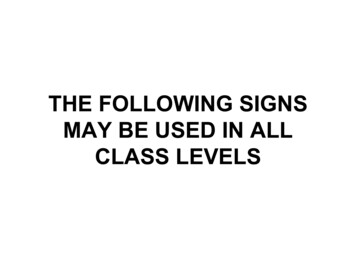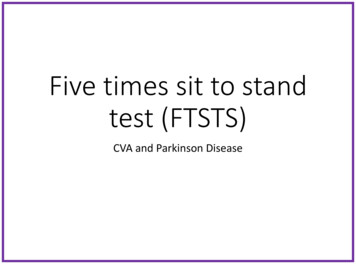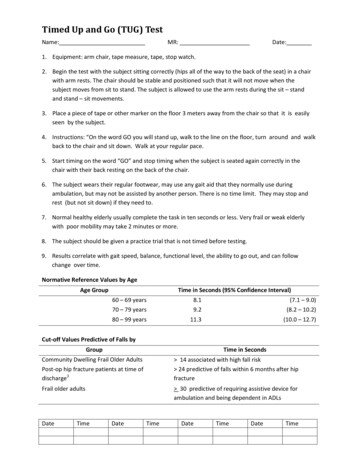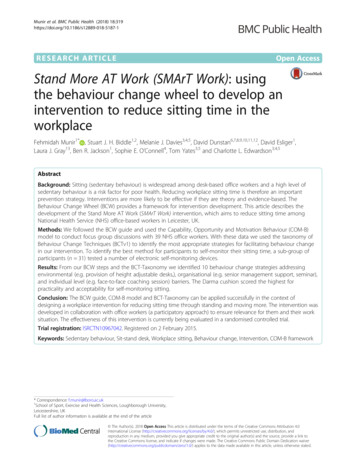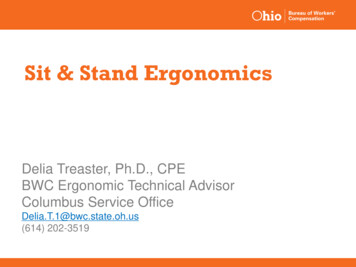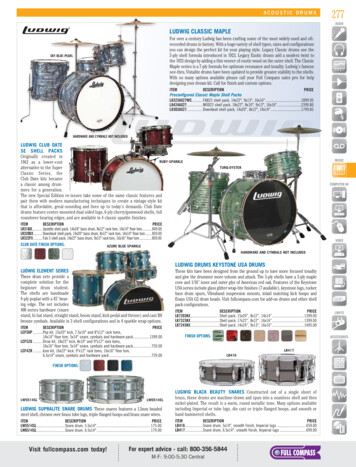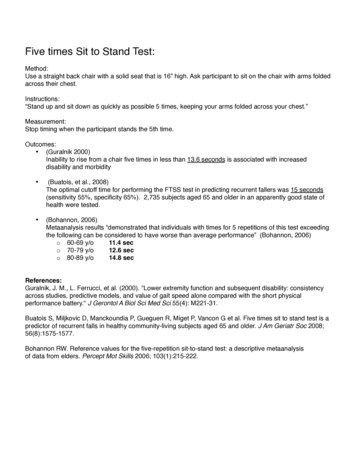
Transcription
Five times Sit to Stand Test:Method:Use a straight back chair with a solid seat that is 16” high. Ask participant to sit on the chair with arms foldedacross their chest.Instructions:“Stand up and sit down as quickly as possible 5 times, keeping your arms folded across your chest.”Measurement:Stop timing when the participant stands the 5th time.Outcomes: (Guralnik 2000)Inability to rise from a chair five times in less than 13.6 seconds is associated with increaseddisability and morbidity (Buatois, et al., 2008)The optimal cutoff time for performing the FTSS test in predicting recurrent fallers was 15 seconds(sensitivity 55%, specificity 65%). 2,735 subjects aged 65 and older in an apparently good state ofhealth were tested. (Bohannon, 2006)Metaanalysis results “demonstrated that individuals with times for 5 repetitions of this test exceedingthe following can be considered to have worse than average performance” (Bohannon, 2006)o 60‐69 y/o11.4 seco 70‐79 y/o12.6 seco 80‐89 y/o14.8 secReferences:Guralnik, J. M., L. Ferrucci, et al. (2000). "Lower extremity function and subsequent disability: consistencyacross studies, predictive models, and value of gait speed alone compared with the short physicalperformance battery." J Gerontol A Biol Sci Med Sci 55(4): M221-31.Buatois S, Miljkovic D, Manckoundia P, Gueguen R, Miget P, Vancon G et al. Five times sit to stand test is apredictor of recurrent falls in healthy community‐living subjects aged 65 and older. J Am Geriatr Soc 2008;56(8):1575‐1577.Bohannon RW. Reference values for the five‐repetition sit‐to‐stand test: a descriptive metaanalysisof data from elders. Percept Mot Skills 2006; 103(1):215‐222.
Patient Name: Date:The Activities-specific Balance Confidence (ABC) Scale*Instructions to Participants: For each of the following activities, please indicate your level of confidencein doing the activity without losing your balance or becoming unsteady from choosing one of thepercentage points on the scale from 0% to 100% If you do not currently do the activity in question, tryand imagine how confident you would be if you had to do the activity. If you normally use a walking aidto do the activity or hold onto someone, rate your confidence as if you were using these supports.0%1020No Confidence30405060708090100%Completely ConfidentHow confident are you that you will not lose your balance or become unsteady when you 1.2.3.4.5.6.7.8.9.10.11.12.13.14.15. walk around the house? % walk up or down stairs? % bend over and pick up a slipper from the front of a closet floor? % reach for a small can off a shelf at eye level? % stand on your tip toes and reach for something above your head? % stand on a chair and reach for something? % sweep the floor? % walk outside the house to a car parked in the driveway? % get into or out of a car? % walk across a parking lot to the mall? % walk up or down a ramp? % walk in a crowded mall where people rapidly walk past you? % are bumped into by people as you walk through the mall? % step onto or off of an escalator while you are holding onto a railing? % step onto or off an escalator while holding onto parcels such that you cannot hold onto therailing? %16. walk outside on icy sidewalks? %*Powell LE & Myers AM. The Activities-specific Balance Confidence (ABC) Scale. Journal of GerontologyMed Sci 1995; 50(1):M28-34.Total ABC Score:Scoring: / 16 Total ABC Score% of self confidenceMEDICARE PATIENTS ONLY100% - % Function % ImpairmentPatient Signature: Date:Therapist Signature: Date:
Berg Balance ScaleThe Berg Balance Scale (BBS) was developed to measure balance among older people withimpairment in balance function by assessing the performance of functional tasks. It is a validinstrument used for evaluation of the effectiveness of interventions and for quantitativedescriptions of function in clinical practice and research. The BBS has been evaluated in severalreliability studies. A recent study of the BBS, which was completed in Finland, indicates that a changeof eight (8) BBS points is required to reveal a genuine change in function between two assessmentsamong older people who are dependent in ADL and living in residential care facilities.Description:14-item scale designed to measure balance of the older adult in a clinical setting.Equipment needed: Ruler, two standard chairs (one with arm rests, one without),footstool or step, stopwatch or wristwatch, 15 ft 0 minutesA five-point scale, ranging from 0-4. “0” indicates the lowest levelof function and “4” the highest level of function. Total Score 5641-56 low fall risk21-40 medium fall risk0 –20 high fall riskA change of 8 points is required to reveal a genuine change in function between 2 assessments.
Berg Balance ScaleName:Date:Location:Rater:ITEM DESCRIPTIONSCORE (0-4)Sitting to standingStanding unsupportedSitting unsupportedStanding to sittingTransfersStanding with eyes closedStanding with feet togetherReaching forward with outstretched armRetrieving object from floorTurning to look behindTurning 360 degreesPlacing alternate foot on stoolStanding with one foot in frontStanding on one footTotalGENERAL INSTRUCTIONSPlease document each task and/or give instructions as written. When scoring, please record thelowest response category that applies for each item.In most items, the subject is asked to maintain a given position for a specific time. Progressivelymore points are deducted if: the time or distance requirements are not met the subject’s performance warrants supervision the subject touches an external support or receives assistance from the examinerSubject should understand that they must maintain their balance while attempting the tasks. Thechoices of which leg to stand on or how far to reach are left to the subject. Poor judgment willadversely influence the performance and the scoring.Equipment required for testing is a stopwatch or watch with a second hand, and a ruler or otherindicator of 2, 5, and 10 inches. Chairs used during testing should be a reasonable height. Eithera step or a stool of average step height may be used for item # 12.
Berg Balance ScaleSITTING TO STANDINGINSTRUCTIONS: Please stand up. Try not to use your hand for support.( )4able to stand without using hands and stabilize independently( )3able to stand independently using hands( )2able to stand using hands after several tries( )1needs minimal aid to stand or stabilize( )0needs moderate or maximal assist to standSTANDING UNSUPPORTEDINSTRUCTIONS: Please stand for two minutes without holding on.( )4able to stand safely for 2 minutes( )3able to stand 2 minutes with supervision( )2able to stand 30 seconds unsupported( )1needs several tries to stand 30 seconds unsupported( )0unable to stand 30 seconds unsupportedIf a subject is able to stand 2 minutes unsupported, score full points for sitting unsupported. Proceed to item #4.SITTING WITH BACK UNSUPPORTED BUT FEET SUPPORTED ON FLOOR OR ON A STOOLINSTRUCTIONS: Please sit with arms folded for 2 minutes.( )4able to sit safely and securely for 2 minutes( )3able to sit 2 minutes under supervision( )2able to able to sit 30 seconds( )1able to sit 10 seconds( )0unable to sit without support 10 secondsSTANDING TO SITTINGINSTRUCTIONS: Please sit down.( )4sits safely with minimal use of hands( )3controls descent by using hands( )2uses back of legs against chair to control descent( )1sits independently but has uncontrolled descent( )0needs assist to sitTRANSFERSINSTRUCTIONS: Arrange chair(s) for pivot transfer. Ask subject to transfer one way toward a seat with armrests and one waytoward a seat without armrests. You may use two chairs (one with and one without armrests) or a bed and a chair.( )4able to transfer safely with minor use of hands( )3able to transfer safely definite need of hands( )2able to transfer with verbal cuing and/or supervision( )1needs one person to assist( )0needs two people to assist or supervise to be safeSTANDING UNSUPPORTED WITH EYES CLOSEDINSTRUCTIONS: Please close your eyes and stand still for 10 seconds.( )4able to stand 10 seconds safely( )3able to stand 10 seconds with supervision( )2able to stand 3 seconds( )1unable to keep eyes closed 3 seconds but stays safely( )0needs help to keep from fallingSTANDING UNSUPPORTED WITH FEET TOGETHERINSTRUCTIONS: Place your feet together and stand without holding on.( )4able to place feet together independently and stand 1 minute safely( )3able to place feet together independently and stand 1 minute with supervision( )2able to place feet together independently but unable to hold for 30 seconds( )1needs help to attain position but able to stand 15 seconds feet together( )0needs help to attain position and unable to hold for 15 seconds
Berg Balance Scale continued REACHING FORWARD WITH OUTSTRETCHED ARM WHILE STANDINGINSTRUCTIONS: Lift arm to 90 degrees. Stretch out your fingers and reach forward as far as you can. (Examiner places a ruler atthe end of fingertips when arm is at 90 degrees. Fingers should not touch the ruler while reaching forward. The recorded measure isthe distance forward that the fingers reach while the subject is in the most forward lean position. When possible, ask subject to useboth arms when reaching to avoid rotation of the trunk.)( )4can reach forward confidently 25 cm (10 inches)( )3can reach forward 12 cm (5 inches)( )2can reach forward 5 cm (2 inches)( )1reaches forward but needs supervision( )0loses balance while trying/requires external supportPICK UP OBJECT FROM THE FLOOR FROM A STANDING POSITIONINSTRUCTIONS: Pick up the shoe/slipper, which is in front of your feet.( )4able to pick up slipper safely and easily( )3able to pick up slipper but needs supervision( )2unable to pick up but reaches 2-5 cm(1-2 inches) from slipper and keeps balance independently( )1unable to pick up and needs supervision while trying( )0unable to try/needs assist to keep from losing balance or fallingTURNING TO LOOK BEHIND OVER LEFT AND RIGHT SHOULDERS WHILE STANDINGINSTRUCTIONS: Turn to look directly behind you over toward the left shoulder. Repeat to the right. (Examiner may pick an objectto look at directly behind the subject to encourage a better twist turn.)( )4looks behind from both sides and weight shifts well( )3looks behind one side only other side shows less weight shift( )2turns sideways only but maintains balance( )1needs supervision when turning( )0needs assist to keep from losing balance or fallingTURN 360 DEGREESINSTRUCTIONS: Turn completely around in a full circle. Pause. Then turn a full circle in the other direction.( )4able to turn 360 degrees safely in 4 seconds or less( )3able to turn 360 degrees safely one side only 4 seconds or less( )2able to turn 360 degrees safely but slowly( )1needs close supervision or verbal cuing( )0needs assistance while turningPLACE ALTERNATE FOOT ON STEP OR STOOL WHILE STANDING UNSUPPORTEDINSTRUCTIONS: Place each foot alternately on the step/stool. Continue until each foot has touched the step/stool four times.( )4able to stand independently and safely and complete 8 steps in 20 seconds( )3able to stand independently and complete 8 steps in 20 seconds( )2able to complete 4 steps without aid with supervision( )1able to complete 2 steps needs minimal assist( )0needs assistance to keep from falling/unable to trySTANDING UNSUPPORTED ONE FOOT IN FRONTINSTRUCTIONS: (DEMONSTRATE TO SUBJECT) Place one foot directly in front of the other. If you feel that you cannot placeyour foot directly in front, try to step far enough ahead that the heel of your forward foot is ahead of the toes of the other foot. (Toscore 3 points, the length of the step should exceed the length of the other foot and the width of the stance should approximate thesubject’s normal stride width.)( )4able to place foot tandem independently and hold 30 seconds( )3able to place foot ahead independently and hold 30 seconds( )2able to take small step independently and hold 30 seconds( )1needs help to step but can hold 15 seconds( )0loses balance while stepping or standingSTANDING ON ONE LEGINSTRUCTIONS: Stand on one leg as long as you can without holding on.( )4able to lift leg independently and hold 10 seconds( )3able to lift leg independently and hold 5-10 seconds( )2able to lift leg independently and hold 3 seconds( )1tries to lift leg unable to hold 3 seconds but remains standing independently.( )0unable to try of needs assist to prevent fall()TOTAL SCORE (Maximum 56)
Four Step Square Test InstructionsGeneral Information:The patient is instructed to stand in square 1 facing square number 2(see figure below)The patient is required to step as fast as possible into each square inthe following sequence: 2, 3, 4, 1, 4, 3, 2, and 1o requires the patient to step forward, backward, and sideway tothe right and leftEquipment required for the FSST includes a stopwatch and 4 canes.Set-up (derived from Dite and Temple 2002): A square is formed with the 4canes by resting them flat on the floor.Patient Instructions (derived from Dite and Temple 2002):“Try to complete the sequence as fast as possible without touchingthe sticks. Both feet must make contact with the floor in each square.If possible, face forward during the entire sequence.”Demonstrate the sequence to the patient.Ask the patient to complete one practice trial to ensure the patientknows the sequence. Repeat the trial if the patient is unsuccessfulDownloaded from www.rehabmeasures.orgTest instructions provided courtesy of Wayne DitePage 1
at completing the sequence, loses balance, or contacts a cane duringthe trial.Two FSST are completed with the best time taken as the score.A score is still provided if the patient is unable to face forward duringthe entire sequence.Scoring:the best time of two FSST is the scorestopwatch starts when the first foot contacts the floor in square 2stopwatch finishes when the last foot comes back to touch the floor insquare 1Downloaded from www.rehabmeasures.orgTest instructions provided courtesy of Wayne DitePage 2
Four Step Square Test (FSST)Name:Assistive Device and/or Bracing Used:Date:Trial 1 sec.Trial 1 sec.FSST Score (best timed trial): sec.Date:Trial 1 sec.Trial 1 sec.FSST Score (best timed trial): sec.Date:Trial 1 sec.Trial 1 sec.FSST Score (best timed trial): sec.Date:Trial 1 sec.Trial 1 sec.FSST Score (best timed trial): sec.Downloaded from www.rehabmeasures.orgTest instructions provided courtesy of Wayne DitePage 3
References:Dite, W. and Temple, V. A. (2002). "A clinical test of stepping and change of direction toidentify multiple falling older adults." Arch Phys Med Rehabil 83(11): 1566-1571.Downloaded from www.rehabmeasures.orgTest instructions provided courtesy of Wayne DitePage 4
Functional Reach Test andModified Functional Reach InstructionsGeneral Information: The Functional Reach test can be administered while the patient isstanding (Functional Reach) or sitting (Modified Functional Reach).Functional Reach (standing instructions):The patient is instructed to next to, but not touching, a wall and position the arm that iscloser to the wall at 90 degrees of shoulder flexion with a closed fist.The assessor records the starting position at the 3rd metacarpal head on the yardstick.Instruct the patient to “Reach as far as you can forward without taking a step.”The location of the 3rd metacarpal is recorded.Scores are determined by assessing the difference between the start and end position isthe reach distance, usually measured in inches.Three trials are done and the average of the last two is noted.Modified Functional Reach Test (Adapted for individuals who are unable to stand):Performed with a leveled yardstick that has been mounted on the wall at the height ofthe patient’s acromion level in the non-affected arm while sitting in a chairHips, knees and ankles positioned are at 90 degree of flexion, with feet positioned flat onthe floor.The initial reach is measured with the patient sitting against the back of the chair withthe upper-extremity flexed to 90 degrees, measure was taken from the distal end of thethird metacarpal along the yardstick.Consists of three conditions over three trialsoSitting with the unaffected side near the wall and leaning forwardoSitting with the back to the wall and leaning rightoSitting with the back to the wall leaning left.Downloaded from www.rehabmeasures.orgPage 1
Instructions should include leaning as far as possible in each direction without rotationand without touching the wallRecord the distance in centimeters covered in each directionIf the patient is unable to raise the affected arm, the distance covered by the acromionduring leaning is recordedFirst trial in each direction is a practice trial and should not included in the final resultA 15 second rest break should be allowed between trialsSet-up:A yardstick and duck tap will be needed for the assessment.The yardstick should be affixed to the wall at the level of the patient’s acromion.References:Duncan, P. W., D. K. Weiner, et al. (1990). "Functional reach: a new clinical measure ofbalance." J Gerontol 45(6): M192-197.Katz-Leurer, M., I. Fisher, et al. (2009). "Reliability and validity of the modified functional reachtest at the sub-acute stage post-stroke." Disabil Rehabil 31(3): 243-248.Weiner, D. K., D. R. Bongiorni, et al. (1993). "Does functional reach improve with rehabilitation?"Arch Phys Med Rehabil 74(8): 796-800.Weiner, D. K., P. W. Duncan, et al. (1992). "Functional reach: a marker of physical frailty." J AmGeriatr Soc 40(3): 203-207.Downloaded from www.rehabmeasures.orgPage 2
Functional Reach Test andModified Functional Reach Score SheetName:Instructions:Instruct the patient to “Reach as far as you can forward without taking a step”Score Sheet:DateTrial One(Practice)Trial TwoTrial ThreeTotal (averageof trial 2 and 3only)Downloaded from www.rehabmeasures.orgPage 3
Falls Efficacy ScaleName:Date:On a scale from 1 to 10, with 1 being very confident and 10 being not confident at all,how confident are you that you do the following activities without falling?Activity:Score:1 very confident10 not confident at allTake a bath or showerReach into cabinets or closetsWalk around the housePrepare meals not requiring carryingheavy or hot objectsGet in and out of bedAnswer the door or telephoneGet in and out of a chairGetting dressed and undressedPersonal grooming (i.e. washing your face)Getting on and off of the toiletTotal ScoreA total score of greater than 70 indicates that the person has a fear offallingAdapted from Tinetti et al (1990)Downloaded from www.rehabmeasures.orgTest instructions provided courtesy of Mary E. Tinetti, MDPage 1
References:Tinetti, M., D. Richman, et al. (1990). "Falls efficacy as a measure of fear of falling." Journal ofgerontology 45(6): P239.Downloaded from www.rehabmeasures.orgTest instructions provided courtesy of Mary E. Tinetti, MDPage 2
TINETTI BALANCE ASSESSMENT TOOLTinetti ME, Williams TF, Mayewski R, Fall Risk Index for elderly patients based on number of chronic disabilities. Am J Med 1986:80:429-434PATIENTS NAMED.o.b.WardBALANCE SECTIONPatient is seated in hard, armless chair;DateSitting BalanceLeans or slides in chairSteady, safe 0 1Rises from chairUnable to without helpAble, uses arms to helpAble without use of arms 0 1 2Attempts to riseUnable to without helpAble, requires 1 attemptAble to rise, 1 attempt 0 1 2Unsteady (staggers, moves feet, trunk sway)Immediate standingSteady but uses walker or other supportBalance (first 5 seconds) Steady without walker or other support 0 1 2Standing balanceUnsteadySteady but wide stance and uses supportNarrow stance without support 0 1 2NudgedBegins to fallStaggers, grabs, catches selfSteady 0 1 2Eyes closedUnsteadySteady 0 1Discontinuous stepsContinuous 0 1Unsteady (grabs, staggers)Steady 0 1Unsafe (misjudged distance, falls into chair)Uses arms or not a smooth motionSafe, smooth motion 0 1 2Turning 360 degreesSitting downBalance score/16/16P.T.O.
TINETTI BALANCE ASSESSMENT TOOLGAIT SECTIONPatient stands with therapist, walks across room ( /- aids), first at usual pace, then at rapid pace.DateIndication of gaitAny hesitancy or multiple attemptsNo hesitancy 0 1Step length and heightStep toStep through RStep through L 0 1 1Foot clearanceFoot dropL foot clears floorR foot clears floor 0 1 1Step symmetryRight and left step length not equalRight and left step length appear equal 0 1Step continuityStopping or discontinuity between stepsSteps appear continuous 0 1PathMarked deviationMild/moderate deviation or uses w. aidStraight without w. aid 0 1 2 0TrunkMarked sway or uses w. aidNo sway but flex. knees or back oruses arms for stabilityNo sway, flex., use of arms or w. aidWalking timeHeels apartHeels almost touching while walking 0 1(Immediately after told to ‘go’.) 1 2Gait score/12/12Balance score carried forward/16/16Total Score Balance Gait score/28/28Risk Indicators:Tinetti Tool ScoreRisk of Falls 18High19-23Moderate 24Low
Timed Up and Go InstructionsGeneral Information (derived from Podsiadlo and Richardson, 1991):The patient should sit on a standard armchair, placing his/her back against thechair and resting his/her arms chair’s arms. Any assistive device used forwalking should be nearby.Regular footwear and customary walking aids should be used.The patient should walk to a line that is 3 meters (9.8 feet) away, turn around atthe line, walk back to the chair, and sit down.The test ends when the patient’s buttocks touch the seat.Patients should be instructed to use a comfortable and safe walking speed.A stopwatch should be used to time the test (in seconds).Set-up:Measure and mark a 3 meter (9.8 feet) walkwayPlace a standard height chair (seat height 46cm, arm height 67cm) at thebeginning of the walkwayPatient Instructions (derived from Podsiadlo and Richardson, 1991):Instruct the patient to sit on the chair and place his/her back against the chair andrest his/her arms chair’s arms.The upper extremities should not be on the assistive device (if used for walking),but it should be nearby.Demonstrate the test to the patient.When the patient is ready, say “Go”The stopwatch should start when you say go, and should be stopped with thepatient’s buttocks touch the seat.Downloaded from www.rehabmeasures.orgTest instructions were derived from the referencePage 1
Timed Up and Go Testing FormName:Assistive Device and/or Bracing Used:Date:TUG Time:Date:TUG Time:Date:TUG Time:Date:TUG Time:Date:TUG Time:Downloaded from www.rehabmeasures.orgTest instructions were derived from the referencePage 2
Reference:Podsiadlo, D. and Richardson, S. (1991). "The timed "Up & Go": a test of basicfunctional mobility for frail elderly persons." J Am Geriatr Soc 39(2): 142-148.Downloaded from www.rehabmeasures.orgTest instructions were derived from the referencePage 3
Five times Sit to Stand Test: Method: Use a straight back chair with a solid seat that is 16” high. Ask participant to sit on the chair with arms folded across their chest. Instructions: “Stand up an
